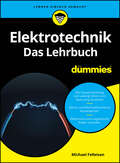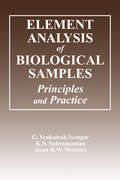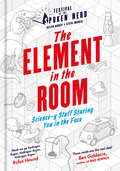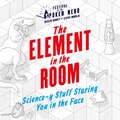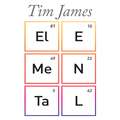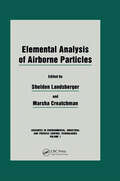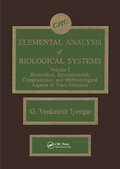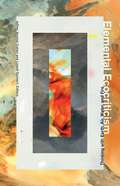- Table View
- List View
Elektromobilität
by Markus LienkampDas wachsende Bedürfnis nach Mobilität in der Bevölkerung lässt sich auf Dauer nur durch den Einsatz elektrischer Klein- und Lieferfahrzeuge für Kurzstrecken befriedigen. Mobilitätsanbieter und Kunden müssen dabei gut vernetzt sein. Die allmähliche Marktdurchdringung der Elektromobilität ist eine große Herausforderung für die Automobilindustrie. Gewinner sind einige gut aufgestellte Automobilhersteller und ein Überraschungssieger. Da die Ölreserven der Erde endlich sind und der Ölpreis in Zukunft steigen dürfte, soll Strom als alternativer Kraftstoff eine Lösung des Problems liefern. Der Autor skizziert aus der Sicht eines Insiders, weshalb ein Wandel unabdingbar ist und beschreibt die notwendigen Schritte.
Elektromobilität – ein Ratgeber für Entscheider, Errichter, Betreiber und Nutzer: Facetten zu Ladeinfrastruktur, Subventionsregeln, Kosten und Handling
by Olaf SchulzeE-Mobilität ist komplex, alle Betroffenen haben gleichen Fragen. Das Buch soll Antworten geben auf die Entscheidung über die nötige und benötigte Ladeinfrastruktur von Ladetechnik, Netzanschluss, Handling, Kostenkalkulation, Nutzerverhalten, E- Fahrzeuge und deren netzdienliches Ladeverhalten, gesetzliche Regelungen für E-Mobilität und Operation, Abrechnung bis zu Webportalen. Es soll Entscheidungshinweise für verschiedene Stakeholder und Entscheiderebenen geben, natürlich auch Wirtschaftlichkeitserwägungen beschreiben. Das Sachbuch soll Trends, Unwägbarkeiten, Regulierungen und internationale Entwicklungen beinhalten und mit einem kritischen Selbstversuch- von der Anschaffung über das Fahren, Laden, App-Anwendungen abschließen. Leser sind Unternehmen, Organisationen und Privatleute, die E-Mobilität in Logistik, Belieferung, Transport und PKW einsetzen wollen.
Elektroneurographie und Elektromyographie kompakt
by Ruben Jimenez-Dominguez Volker MilnikDer kompakte Taschenatlas stellt mithilfe von Flussdiagrammen und Fotos wesentliche Konzepte für die Durchführung, Interpretation und Befundung der Elektroneurographie und Elektromyographie dar, nützlich für alle in der Elektrophysiologie tätigen Ärzte und MTAs. Die neurophysiologische Diagnostik ist als verlängerter Arm der Anamnese und der klinischen Untersuchung ein bedeutender Bestandteil der Evaluation von Erkrankungen des peripheren Nervensystems. Dieses Buch bietet eine schnelle Übersicht mit den wichtigsten Tools für die Untersuchungen im elektrophysiologischen Labor.
Elektronik Design: Theorie und Praxis
by Ralf Schmidt Dirk Hauschild Ines KlugeDieses Buch gibt einen Überblick über die wichtigsten Bereiche zur Entwicklung und Konstruktion elektronischer Geräte, zusammengefasst unter dem Begriff Elektronik Design, und beginnt mit der Bereitstellung des Stromlaufplans.In zunehmendem Maße erfordert die Realisierung von Elektronik durch immer kleinere Bauelemente, die direkte Verarbeitung von Halbleiterchips, zunehmende Taktfrequenzen und Verlustleistungen interdisziplinäre Betrachtungen von Design, Technologien und Werkstoffen. Aus diesem Grund wurde den Darstellungen der Technologien größerer Raum gegeben.Die Kapitel sind so gestaltet, dass sie auch einzeln für sich gelesen werden können. Einige Inhalte sind in mehreren Kapiteln zu finden, da eindeutige Zuordnungen nicht immer möglich oder sinnvoll sind.
Elektronik. Hightech in Patenten: Von der Funktelegraphie, dem Transistor bis zum Quantencomputer
by Thomas Heinz MeitingerElektronische Schaltungen werden heutzutage zumeist aus kristallinen Halbleitern hergestellt, in die Fremdatome eingebracht werden (Dotierung). Die Anfänge der Elektronik kennzeichnen jedoch die Elektronenröhren, mit denen die ersten gleichrichtenden und schaltenden Funktionen verwirklicht wurden. Die ersten, auf dieser Technologie basierenden Computer hatten eine geringe Leistung, wiesen dennoch gewaltige räumliche Ausmaße auf. Erst mit der Verwendung von dotierten Halbleitern begann die Miniaturisierung und die dynamische Entwicklung der Elektronik. Dieses Buch zeigt die Entwicklung der hierfür erforderlichen Elektronik von der Analogtechnik mit den Operationsverstärkern über die Digitaltechnik, die letzten Endes ins Computerzeitalter geführt hat, und der Hochfrequenztechnik, die entscheidend die Nachrichtenübertragung bestimmt hat, bis hin zur Leistungselektronik, die eine elektrische Energieversorgung ermöglicht. In diesem Buch werden die hierfür benötigten Erfindungen und die resultierende technische Entwicklung anhand der Hauptansprüche und Zeichnungen aus Patentschriften vorgestellt.
Elektronik im Physikstudium: Eine Einführung geeignet zur Vorlesung, im Praktikum und im Labor
by Tobias Bisanz Ingrid-Maria Gregor Fabian Hügging Jens WeingartenDieses Buch wendet sich an Studierende naturwissenschaftlicher Studiengänge und eignet sich als perfekter Begleiter für Vorlesungen und Praktika zu den Grundlagen der analogen und digitalen Elektronik. Der Inhalt entspricht einer typischen ein- bis zweisemestrigen Vorlesung in den physikalischen Studiengängen (z.B. Physik und Medizinphysik). Dabei werden keine Kenntnisse der höheren Mathematik oder komplexer Physik vorausgesetzt, so dass das Buch auch für Studierende anderer naturwissenschaftlicher Studiengänge zugänglich ist. Das didaktische Konzept und die klare Sprache helfen beim Verständnis und der Vertiefung des Stoffes. Der Aufbau folgt einer typischen Elektronik-Vorlesung von den Grundlagen wie Strom und Spannung über die wichtigsten Halbleiterbauelemente bis hin zu Grundlagen und Anwendungen der digitalen Elektronik. Abschließend wird als Beispiel für die Anwendung des erarbeiteten Verständnisses die elektronische Erfassung von Messwerten besprochen, wie sie sehr oft in der Laborpraxis naturwissenschaftlicher Berufe benutzt wird.
Elektrophorese leicht gemacht: Ein Praxisbuch für Anwender
by Reiner WestermeierDie zweite Auflage eines Standardwerks: Alle wichtigen Aspekte und Techniken der Elektrophorese werden abgedeckt, von SDS-PAGE und Isotachophorese bis zu isoelektrischer Fokussierung, blauer Nativ-Elektrophorese und zweidimensionalen Methoden. Speziell auf die Bedurfnisse von Laboranten und technischen Angestellten zugeschnitten, stehen praktische Gesichtspunkte und Methoden im Mittelpunkt des Buchs. Nach einem Uberblick uber alle gangigen Elektrophoresetechniken mit einer Einfuhrung in Detektion, Musterauswertung und Proteomik folgen Kapitel zu Instrumentierung und benotigten Arbeitsmaterialien. Detaillierte Methodenanleitungen erleichtern auch dem Anfanger den praktischen Einstieg in die Welt der Elektrophorese. Die Begleitwebsite mit zahlreichen Animationen ermoglicht einen zusatzlichen visuellen Zugang zu den einzelnen Techniken.
Elektrophysiologie: Grundlagen - Methoden - Anwendungen
by Jürgen Rettinger Silvia Schwarz Wolfgang SchwarzDieses Lehrbuch bietet einen umfassenden Überblick zur zellulären Elektrophysiologie. Die Themen reichen von bioelektrischen Phänomenen, die schon im antiken Ägypten beschrieben wurden, bis hin zu aktuellen Streitfragen wie der Gefahr durch Elektrosmog. Dieses kurz und prägnant geschriebene Werk beschreibt wissenschaftlich präzise verschiedene Methoden und Anwendungen der Elektrophysiologie sowie die biophysiologischen Grundlagen von Ionenkanälen und Carrier-Proteinen. Zahlreiche sorgsam ausgewählte Illustrationen und Grafiken ergänzen das Geschriebene, während Fragen am Ende jedes Kapitels dem Leser die Möglichkeit zur Selbstkontrolle bieten. Jeder Abschnitt enthält zudem Verweise auf relevante Publikationen und Literaturstellen, die für ein tieferes Verständnis zu Rate gezogen werden können. Das Buch stellt somit eine wertvolle Informationsquelle für Studierende der Biologie, Chemie und Physik dar, die sich speziell für Biophysik interessieren.
Elektrosmog und Ökoboom: Ein naturwissenschaftlicher Blick auf populäres Halbwissen
by Werner MänteleWas ist wirklich dran an den Gefahren durch Elektrosmog, Gentechnik und Radioaktivität? Sind die Risiken durch Feinstaub und Stickoxide in unseren Städten tatsächlich so groß, wie oft behauptet wird? Gibt es Gründe zu glauben, dass Funkmasten und Hochspannungsleitungen unsere Gesundheit gefährden? Und ist „Öko…” automatisch immer gut? Dieses Buch geht solchen Fragen mit einer soliden wissenschaftlichen Arbeitsweise nach. Es hilft Ihnen dabei, den Hintergrund der befürchteten Risiken zu verstehen und mögliche Gefahren, aber auch Chancen richtig einzuordnen. Von der Mobiltelefonie über die Energiewende bis zur Gentechnik behandelt das Buch Themen, die in unserer Gesellschaft sehr kontrovers und teilweise emotional diskutiert werden. Der Autor führt Sie kurzweilig durch die wissenschaftlichen Grundlagen und klärt Sie mit Augenzwinkern über populäre Irrtümer und Fehlvorstellungen auf. Er zeigt Ihnen, wie Sie in Medien oder im Internet Quellen für solide Informationen finden, denen Sie vertrauen können und die nicht von Ideologien geprägt sind. So ermöglicht die Lektüre des Buches Ihnen ein eigenes, wissenschaftlich begründetes Urteil.
Elektrotechnik für Dummies. Das Lehrbuch (Für Dummies)
by Michael FelleisenElektrotechnik ohne Schnick, nur mit (ein wenig) Schnack Michael Felleisen erläutert in diesem Buch, was Sie über Stromkreise und Widerstände, elektrische Felder und Kondensatoren wissen müssen. Weiter erklärt er Ihnen, was es mit der Wechselstromtechnik, magnetischen Feldern und Spulen auf sich hat. Auch nicht zu kurz kommen Frequenzgang, Ortskurve, Filterschaltungen und Dreiphasen-Wechselstromsysteme. Mit Übungsaufgaben und ausführlichen Lösungen können Sie Ihr Wissen überprüfen und festigen. So ist dieses Buch eine umfangreiche Einführung in die Elektrotechnik und Ihr freundlicher Begleiter durch das Studium. Sie erfahren Wie Ladung, Strom und Spannung zusammenhängen Wie Sie Gleichstromkreise zeichnen und wie diese wirken Was es mit Flussdichte und Dielektrizitätskonstante auf sich hat Was es über Wechselstromkreise zu wissen gibt
Elektrotechnik und Elektronik: Für Maschinenbauer und Verfahrenstechniker
by Michael Beck Rudolf BuschDieses Lehrbuch legt neben einer anschaulichen Darstellung der Grundlagen von elektrischen und magnetischen Feldern und Stromkreisen den Schwerpunkt auf die Anwendungen in Elektronik, elektrischen Maschinen, Energieversorgung und Messtechnik. Dabei gibt es zu jedem Kapitel Übungsaufgaben unterschiedlichen Schwierigkeitsgrades, um das Erlernte zu prüfen und zu festigen. Die vorliegende 8. Auflage wurde auf den aktuellen Stand der Technik gebracht. Das trifft insbesondere auf den Teil B zu (Anwendungen der Elektrotechnik). Im Vordergrund stehen dabei Elektronik und elektrische Messtechnik sowie der Asynchronmotor in seiner Anwendung in geregelten elektrischen Antrieben. Im Zusammenhang mit der breiteren Nutzung erneuerbarer Energien werden die verwendeten Techniken und Technologien beschrieben.
Element Analysis of Biological Samples: Principles and Practices, Volume II
by G. Venkatesh Iyengar K. S. Subramanian Joost R.W. WoittiezDespite the development of innovative new analytical techniques for biological trace element research, today's trace element investigators face formidable obstacles to obtaining reliable data. This complete reference identifies and assesses the challenges the analyst encounters at each stage of an analysis, and discusses the effects of various techniques on the sample.Three internationally recognized scientists and authors consider the effects of the numerous collection, storage, and sample preparatory techniques used in sample analysis. Proper analytical quality control, including such critical factors as sampling and sample preparation, specimen preservation and storage, and ashing, is examined. The book also looks at sample preparation methods unique to various instruments and speciation chemistry issues, and examines the link between chemical analysis and specimen banking. A previously unrecognized source of error, presampling factors, is also discussed.
The Element in the Room: Science-y Stuff Staring You in the Face
by Helen Arney Steve Mould'Made me go Hydrogen Argon, Hydrogen Argon, Hydrogen Argon.' Rufus HoundAs featured in Best stocking-filler books of 2017 - The Guardian'Witty and clever writing, every topic is engaging, fun and in some cases laugh-out-loud funny...there are too many highlights to mention' - How it Works Why is it impossible to spin your right foot clockwise while you draw a 6 with your right hand? Can you extract DNA from a strawberry daiquiri? Would you make love like a praying mantis? Should you book a holiday on Earth 2.0? The Element in the Room will take you on a rib-tickling, experiment-fuelled adventure to explain everyday science that is staring you in the face. If you are sci-curious, pi-curious or just the-end-is-nigh-curious then this is the book for you.Steve Mould and Helen Arney are two thirds of science comedy phenomenon Festival of the Spoken Nerd. As a trio they have appeared on QI, created their own experimental* comedy show 'Domestic Science' for Radio 4, toured their stand-up science shows to over 50,000 nerds (and non-nerds) and accumulated millions of views on YouTube.'These nerds are the real deal' - Ben Goldacre, author of BAD SCIENCE 'They make science fun and understandable which is a great combo.' Sandi Toksvig'MIND BLOWN.' Tim Harford'Science was never such hilarious explosive fun.' Richard Herring'This book is 37% better than mine. But it took 100% more nerds to write it.' Matt Parker (the other third of Spoken Nerd)
The Element in the Room: Science-y Stuff Staring You In The Face
by Helen Arney Steve Mould'They make science fun and understandable which is a great combo.' Sandi Toksvig 'These nerds are the real deal.' Ben Goldacre, author of BAD SCIENCE Why is it impossible to spin your right foot clockwise while you draw a 6 with your right hand? Can you extract DNA from a strawberry daiquiri? Would you make love like a praying mantis? Should you book a holiday on Earth 2.0? The Element in the Room will take you on a rib-tickling, experiment-fuelled adventure to explain everyday science that is staring you in the face. If you are sci-curious, pi-curious or just the-end-is-nigh-curious then this is the book for you.Steve Mould and Helen Arney are two thirds of science comedy phenomenon Festival of the Spoken Nerd. As a trio they have appeared on QI, created their own experimental* comedy show 'Domestic Science' for Radio 4, toured their stand-up science shows to over 50,000 nerds (and non-nerds) and accumulated millions of views on YouTube.'Made me go Hydrogen Argon, Hydrogen Argon, Hydrogen Argon.' Rufus Hound'MIND BLOWN.' Tim Harford'Science was never such hilarious explosive fun.' Richard Herring'This book is 37% better than mine. But it took 100% more nerds to write it.' Matt Parker (the other third of Spoken Nerd)
The Element in the Room: Science-y Stuff Staring You in the Face
by Helen Arney Steve Mould'Made me go Hydrogen Argon, Hydrogen Argon, Hydrogen Argon.' Rufus Hound As featured in Best stocking-filler books of 2017 - The Guardian 'Witty and clever writing, every topic is engaging, fun and in some cases laugh-out-loud funny...there are too many highlights to mention' - How it Works Why is it impossible to spin your right foot clockwise while you draw a 6 with your right hand? Can you extract DNA from a strawberry daiquiri? Would you make love like a praying mantis? Should you book a holiday on Earth 2.0? The Element in the Room will take you on a rib-tickling, experiment-fuelled adventure to explain everyday science that is staring you in the face. If you are sci-curious, pi-curious or just the-end-is-nigh-curious then this is the book for you. Steve Mould and Helen Arney are two thirds of science comedy phenomenon Festival of the Spoken Nerd. As a trio they have appeared on QI, created their own experimental* comedy show 'Domestic Science' for Radio 4, toured their stand-up science shows to over 50,000 nerds (and non-nerds) and accumulated millions of views on YouTube. 'These nerds are the real deal' - Ben Goldacre, author of BAD SCIENCE 'They make science fun and understandable which is a great combo.' Sandi Toksvig 'MIND BLOWN.' Tim Harford 'Science was never such hilarious explosive fun.' Richard Herring 'This book is 37% better than mine. But it took 100% more nerds to write it.' Matt Parker (the other third of Spoken Nerd)
The Element in the Room: Science-y Stuff Staring You in the Face
by Helen Arney Steve Mould'They make science fun and understandable which is a great combo.' Sandi Toksvig 'These nerds are the real deal.' Ben Goldacre, author of BAD SCIENCE Why is it impossible to spin your right foot clockwise while you draw a 6 with your right hand? Can you extract DNA from a strawberry daiquiri? Would you make love like a praying mantis? Should you book a holiday on Earth 2.0? The Element in the Room will take you on a rib-tickling, experiment-fuelled adventure to explain everyday science that is staring you in the face. If you are sci-curious, pi-curious or just the-end-is-nigh-curious then this is the book for you.Steve Mould and Helen Arney are two thirds of science comedy phenomenon Festival of the Spoken Nerd. As a trio they have appeared on QI, created their own experimental* comedy show 'Domestic Science' for Radio 4, toured their stand-up science shows to over 50,000 nerds (and non-nerds) and accumulated millions of views on YouTube.'Made me go Hydrogen Argon, Hydrogen Argon, Hydrogen Argon.' Rufus Hound'MIND BLOWN.' Tim Harford'Science was never such hilarious explosive fun.' Richard Herring'This book is 37% better than mine. But it took 100% more nerds to write it.' Matt Parker (the other third of Spoken Nerd)(P) 2017 Octopus Publishing Group
Elemental: How the Periodic Table Can Now Explain (Nearly) Everything
by Tim JamesSELECTED AS ONE OF THE BEST BOOKS OF 2018 BY THE DAILY MAIL 'A hugely entertaining tour of the periodic table and the 118 elements that are the basic building blocks of everything' Daily MailIn 2016, with the addition of four final elements - nihonium, moscovium, tennessine and oganesson - to make a total of 118 elements, the periodic table was finally complete, rendering any pre-existing books on the subject obsolete.Tim James, the science YouTuber and secondary-school teacher we all wish we'd had, provides an accessible and wonderfully entertaining 'biography of chemistry' that uses stories to explain the positions and patterns of elements in the periodic table. Many popular science titles tend to tell the history of scientific developments, leaving the actual science largely unexplained; James, however, makes use of stories to explain the principles of chemistry within the table, showing its relevance to everyday life.Quirkily illustrated and filled with humour, this is the perfect book for students wanting to learn chemistry or for parents wanting to help, but it is also for anyone who wants to understand how our world works at a fundamental level. The periodic table, that abstract and seemingly jumbled graphic, holds (nearly) all the answers. As James puts it, elements are 'the building blocks nature uses for cosmic cookery: the purest substances making up everything from beetroot to bicycles.'Whether you're studying the periodic table for the first time or are simply interested in the fundamental building blocks of the universe - from the core of the sun to the networks in our brains - Elemental is the perfect guide.Website: timjamesscience.com YouTube: timjamesScience Twitter: @tjamesScience
Elemental: How the Periodic Table Can Now Explain (Nearly) Everything
by Tim JamesSELECTED AS ONE OF THE BEST BOOKS OF 2018 BY THE DAILY MAIL 'A hugely entertaining tour of the periodic table and the 118 elements that are the basic building blocks of everything' Daily MailIn 2016, with the addition of four final elements - nihonium, moscovium, tennessine and oganesson - to make a total of 118 elements, the periodic table was finally complete, rendering any pre-existing books on the subject obsolete.Tim James, the science YouTuber and secondary-school teacher we all wish we'd had, provides an accessible and wonderfully entertaining 'biography of chemistry' that uses stories to explain the positions and patterns of elements in the periodic table. Many popular science titles tend to tell the history of scientific developments, leaving the actual science largely unexplained; James, however, makes use of stories to explain the principles of chemistry within the table, showing its relevance to everyday life.Quirkily illustrated and filled with humour, this is the perfect book for students wanting to learn chemistry or for parents wanting to help, but it is also for anyone who wants to understand how our world works at a fundamental level. The periodic table, that abstract and seemingly jumbled graphic, holds (nearly) all the answers. As James puts it, elements are 'the building blocks nature uses for cosmic cookery: the purest substances making up everything from beetroot to bicycles.'Whether you're studying the periodic table for the first time or are simply interested in the fundamental building blocks of the universe - from the core of the sun to the networks in our brains - Elemental is the perfect guide.Website: timjamesscience.com YouTube: timjamesScience Twitter: @tjamesScience
Elemental: How the Periodic Table Can Now Explain (Nearly) Everything
by Tim JamesSELECTED AS ONE OF THE BEST BOOKS OF 2018 BY THE DAILY MAIL 'A hugely entertaining tour of the periodic table and the 118 elements that are the basic building blocks of everything' Daily MailIn 2016, with the addition of four final elements - nihonium, moscovium, tennessine and oganesson - to make a total of 118 elements, the periodic table was finally complete, rendering any pre-existing books on the subject obsolete.Tim James, the science YouTuber and secondary-school teacher we all wish we'd had, provides an accessible and wonderfully entertaining 'biography of chemistry' that uses stories to explain the positions and patterns of elements in the periodic table. Many popular science titles tend to tell the history of scientific developments, leaving the actual science largely unexplained; James, however, makes use of stories to explain the principles of chemistry within the table, showing its relevance to everyday life.Quirkily illustrated and filled with humour, this is the perfect book for students wanting to learn chemistry or for parents wanting to help, but it is also for anyone who wants to understand how our world works at a fundamental level. The periodic table, that abstract and seemingly jumbled graphic, holds (nearly) all the answers. As James puts it, elements are 'the building blocks nature uses for cosmic cookery: the purest substances making up everything from beetroot to bicycles.'Whether you're studying the periodic table for the first time or are simply interested in the fundamental building blocks of the universe - from the core of the sun to the networks in our brains - Elemental is the perfect guide.Website: timjamesscience.com YouTube: timjamesScience Twitter: @tjamesScience
Elemental: How Five Elements Changed Earth’s Past and Will Shape Our Future
by Stephen PorderAn ecologist explores how life itself shapes Earth using the elemental constituents we all shareIt is rare for life to change Earth, yet three organisms have profoundly transformed our planet over the long course of its history. Elemental reveals how microbes, plants, and people used the fundamental building blocks of life to alter the climate, and with it, the trajectory of life on Earth in the past, present, and future.Taking readers from the deep geologic past to our current era of human dominance, Stephen Porder focuses on five of life&’s essential elements—hydrogen, oxygen, carbon, nitrogen, and phosphorus. He describes how single-celled cyanobacteria and plants harnessed them to wildly proliferate across the oceans and the land, only to eventually precipitate environmental catastrophes. He then brings us to the present, and shows how these elements underpin the success of human civilization, and how their mismanagement threatens similarly catastrophic unintended consequences. But, Porder argues, if we can learn from our world-changing predecessors, we can construct a more sustainable future.Blending conversational storytelling with the latest science, Porder takes us deep into the Amazon, across fresh lava flows in Hawaii, and to the cornfields of the American Midwest to illuminate a potential path to sustainability, informed by the constraints imposed by life&’s essential elements and the four-billion-year history of life on Earth.
Elemental Analysis by Particle Accelerators
by Zeev Alfassi Max PeisachElemental Analysis by Particle Accelerators describes the theory, methodology, and applications for a wide variety of sensitive, non-destructive methods of analysis capable of both high selectivity and multielemental determinations. Specific methods discussed include radioactive methods, particle backscatter analysis, recoil techniques, and nuclear reaction analysis. The use of multielemental PIXE and PIGME analyses of "real world" thick samples in environmental studies, trace element applications in biology, and provenance studies in archaeology are also covered. The book is a useful reference for practicing specialists and an essential text for students.
Elemental Analysis of Airborne Particles
by Sheldon Landsberger Marsha CreatchmanAn increased standard of living in developed and developing countries has brought about a distinct rise in pollution. The problem of air pollution has specifically increased the public's awareness of the environmental and health-related consequences resulting from modern day industrial technology. This detailed collection of works devoted to the most popular methods in elemental analysis of airborne particles offers investigators a comprehensive book on the most common laboratory analytical methods currently used in trace element analysis. Discussed are atomic absorption spectrometry, inductively coupled plasma, atomic emission, particle induced gamma ray analysis, particle elastic scattering and Rutherford backscattering, and neutron activation analysis. Specific sections on quality assurance/quality control and source receptor modeling have also been included.
Elemental Analysis of Biological Systems: Biological, Medical, Environmental, Compositional, and Methodological Aspects, Volume I
by G. Venkatesh IyengarThe purpose of this volume is to emphasize the fact that biological trace element research is a multidisciplinary science which requires a prudent combination of biological insight and analytical awareness. The text frequently stresses that accurate measurements on biologically and analytically "valid" samples hold the key for success in future investigations. It reminds the analytical scientists and the life sciences researchers that their perceptions should extend beyond conventional limits - namely, the former as generators of data and the latter as interpreters of those findings. This book enables the reader to understand the intricacies of elemental composition studies in biological systems, and also provides a valuable source of information to biologists, biochemists, physicians, nutritionists and related scientific workers who intend to draw meaningful conclusions from the analytical findings.
Elemental Ecocriticism: Thinking with Earth, Air, Water, and Fire
by Jeffrey Jerome Cohen Lowell DuckertFor centuries it was believed that all matter was composed of four elements: earth, air, water, and fire in promiscuous combination, bound by love and pulled apart by strife. Elemental theory offered a mode of understanding materiality that did not center the cosmos around the human. Outgrown as a science, the elements are now what we build our houses against. Their renunciation has fostered only estrangement from the material world. The essays collected in Elemental Ecocriticism show how elemental materiality precipitates new engagements with the ecological. Here the classical elements reveal the vitality of supposedly inert substances (mud, water, earth, air), chemical processes (fire), and natural phenomena, as well as the promise in the abandoned and the unreal (ether, phlogiston, spontaneous generation). Decentering the human, this volume provides important correctives to the idea of the material world as mere resource. Three response essays meditate on the connections of this collaborative project to the framing of modern-day ecological concerns. A renewed intimacy with the elemental holds the potential of a more dynamic environmental ethics and the possibility of a reinvigorated materialism.
Elemental-Embodied Thinking for a New Era (Sophia Studies in Cross-cultural Philosophy of Traditions and Cultures #42)
by Lenart Škof Sigridur Thorgeirsdottir SashinunglaThis collection responds to widespread, complex, and current environmental challenges by presenting eleven original essays on a new elemental-embodied approach in environmental humanities. This approach has a special focus on elemental and indigenous philosophies as well as localized experiences of terrestrial forces: from earthquakes and eruptions to pandemics and natural disasters. Representing a shift in modern Western scientific and disembodied thinking of nature, this edited book approaches the question of relationality and intertwining of human and natural being by utilizing the elemental-embodied methodologies within philosophy of embodiment and nature. Supported by research in cognitive sciences, the contributors represent the experiential and affective turn within research into human cognition. As embodied, the human being is embedded and interacting with all there is. The aim of this edited volume is to indicate new paths toward regaining our access to natural being within usand thus toward reconnecting with the natural environment and the things and beings around us in a new, environmentally enhanced way. It appeals to researchers and students working in many fields, predominantly in philosophy, as well as religious and environmental studies.









